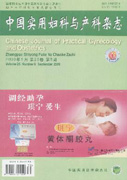Abstract:Recurrence is an important,common issue,and is difficult to handle in the diagnosis and treatment of endometriosis.Deeply infiltrating endometriosis has low recurrence rate,and residual lesions of previous surgery is considered to be the main reason of recurrence.Recurrent patients have massive adhesions,deeply focal invasion,increased surgical complications and difficulty for surgery,and could be technically demanding.A second surgery must be based on a detailed risk-benefit evaluation before implementation.Preoperative and postoperative evaluation and drug treatment should be stressed,and systematic management should be emphasized.

